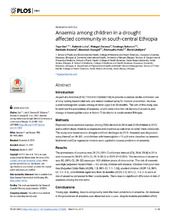| dc.contributor.author | Gari, Taye | en_US |
| dc.contributor.author | Loha, Eskindir | en_US |
| dc.contributor.author | Deressa, Wakgari | en_US |
| dc.contributor.author | Solomon, Tarekegn | en_US |
| dc.contributor.author | Atsbeha, Hanibale | en_US |
| dc.contributor.author | Assegid, Meselech | en_US |
| dc.contributor.author | Hailu, Alemayehu | en_US |
| dc.contributor.author | Lindtjørn, Bernt | en_US |
| dc.date.accessioned | 2018-07-04T11:41:25Z | |
| dc.date.available | 2018-07-04T11:41:25Z | |
| dc.date.issued | 2017-03-14 | |
| dc.Published | Gari T, Loha E, Deressa W, Solomon, Atsbeha, Assegid, Hailu A, Lindtjorn B. Anaemia among children in a drought affected community in south-central Ethiopia. PLoS ONE. 2017;12(3):e0170898 | eng |
| dc.identifier.issn | 1932-6203 | |
| dc.identifier.uri | https://hdl.handle.net/1956/17865 | |
| dc.description.abstract | Introduction: As part of a field trial (PACTR201411000882128) to provide evidence on the combined use of long-lasting insecticidal nets and indoor residual spray for malaria prevention, we measured haemoglobin values among children aged 6 to 59 months. The aim of this study was to estimate the prevalence of anaemia, and to determine the risk factors of anaemia and change in haemoglobin value in Adami Tullu district in south-central Ethiopia. Methods: Repeated cross-sectional surveys among 2984 children in 2014 and 3128 children in 2015; and a cohort study (malaria as exposure and anaemia as outcome variable) were conducted. The study area faced severe drought and food shortages in 2015. Anaemia was diagnosed using HemoCue Hb 301, and children with haemoglobin <11 g/dl were classified as anaemic. Multilevel and Cox regression models were applied to assess predictors of anaemia. Results: The prevalence of anaemia was 28.2% [95% Confidence Interval (CI), 26.6–29.8] in 2014 and increased to 36.8% (95% CI, 35.1–38.5) in 2015 (P<0.001). The incidence of anaemia was 30; (95% CI, 28–32) cases per 100 children years of observation. The risk of anaemia was high (adjusted Hazard Ratio = 10) among children with malaria. Children from poor families [Adjusted Odds Ratio (AOR); 1.3; 95% CI, 1.1–1.6)], stunted children (AOR 1.5; 95% CI; 1.2–1.8), and children aged less than 36 months (AOR; 2.0; 95% CI, 1.6–2.4) were at risk of anaemia compared to their counterparts. There was no significant difference in risk of anaemia among the trial arms. Conclusions: Young age, stunting, malaria and poverty were the main predictors of anaemia. An increase in the prevalence of anaemia was observed over a year, despite malaria prevention effort, which could be related to the drought and food shortage. Therefore, conducting trials in settings prone to drought and famine may bring unexpected challenges. | en_US |
| dc.language.iso | eng | eng |
| dc.publisher | Public Library of Science | eng |
| dc.relation.ispartof | <a href="http://hdl.handle.net/1956/17867" target="blank"> Malaria, anaemia and undernutrition in a drought-affected area of the Rift Valley of Ethiopia: Experiences from a trial to prevent malaria</a> | |
| dc.rights | Attribution CC BY | eng |
| dc.rights.uri | http://creativecommons.org/licenses/by/4.0/ | eng |
| dc.title | Anaemia among children in a drought affected community in south-central Ethiopia | en_US |
| dc.type | Peer reviewed | |
| dc.type | Journal article | |
| dc.date.updated | 2018-03-05T13:29:23Z | |
| dc.description.version | publishedVersion | en_US |
| dc.rights.holder | Copyright 2017 Gari et al. | |
| dc.identifier.doi | https://doi.org/10.1371/journal.pone.0170898 | |
| dc.identifier.cristin | 1547889 | |
| dc.source.journal | PLoS ONE | |
| dc.relation.project | Norges forskningsråd: 220554 | |

